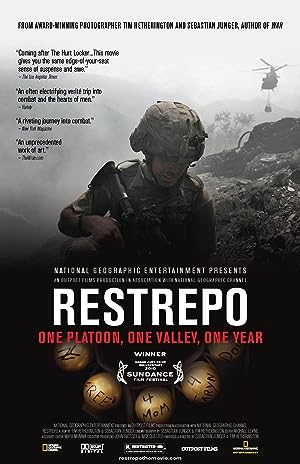Restrepo is a well-respected documentary by Sebastian Junger who was embedded with the Second Platoon, B Company, 2nd Battalion, 503rd Infantry Regiment, 173rd Airborne Brigade Combat Team of the U.S. Army in the Korangal Valley. While I may appreciate how objectively difficult it is to shoot a documentary during war and how the amount of coverage is unprecedented, the actual final product felt two dimensional and superficial like a home video of war.
There are many different types of documentaries. There are expository documentaries, which I like to call the PBS style. They are highly structured and narrated in order to make the audience understand the subject thoroughly. There is cinema verite or observational documentaries, which only uses the footage without narration to explain the events. The editing of the footage sculpts the tale. Restrepo occasionally intersperses narration and confessionals from the soldiers to shed light on what the footage is, but there is no rhythm to this narration device, and it gave me no deeper insight to the men on duty as unique individuals, but only as a collective group.
Restrepo is an unsatisfactory hybrid. Restrepo believes that it is enough to visually capture the exact point when men are grieving a fresh loss, but it also has to make the audience invested enough in the men as unforgettable individuals that we know to feel that loss as keenly as they do while watching the film. There is a brief glimmer of joy when the men dance to a remix of Samantha Fox’s Touch Me.
Restrepo does reveal the chasm between what the men are trying to achieve and what is actually being done. When the soldiers suggest to the locals that they should just wipe the slate clean and start again, even I knew how culturally unprepared they were for the task that they received. They are in a place where nothing is forgotten, and it is fraught with history. These are soldiers, not trained negotiators or diplomats. They cannot succeed with these tools even with the best intentions.
Restrepo also reveals that battle is like screaming into an unseen void. The countryside can suddenly erupt into gunfire, and the possibility of friendly fire is feasible. War is a faceless, theoretical enemy with real world results.
Restrepo shows, but does not illuminate. I want a portrait of a soldier’s soul or soldiers’ souls, not just security footage. These were individuals with a past and hopes for the future, which they bring to every present moment. Restrepo restricts it to the physical present and creates an artificial anonymity that may accurately depict what literally happened, but does not accurately represent what it is like to be a human being that exists in a multidimensional plane even in the present moment.
Stay In The Know
Join my mailing list to get updates about recent reviews, upcoming speaking engagements, and film news.





